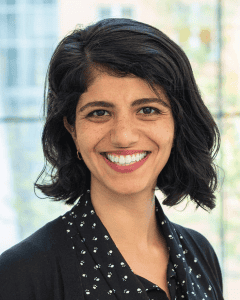Monday, May 19, 2025, 12:30 – 2:30 pm, Talk Room 2
The Vision Sciences Society is honored to present Leyla Isik with the 2025 Elsevier/VSS Young Investigator Award.
The Elsevier/VSS Young Investigator Award, sponsored by Vision Research, is given to an early-career vision scientist who has made outstanding contributions to the field. The nature of this work can be fundamental, clinical, or applied. The award selection committee gives highest weight to the significance, originality and potential long-range impact of the work. The selection committee may also take into account the nominee’s previous participation in VSS conferences or activities, and substantial obstacles that the nominee may have overcome in their careers. The awardee is asked to give a brief presentation of her/his work and is required to write an article to be published in Vision Research.

Leyla Isik
Clare Boothe Luce Assistant Professor, Department of Cognitive Science, Johns Hopkins University
The 2025 Elsevier/VSS Young Investigator Award goes to Professor Leyla Isik for her important contributions to the scientific study of social vision. Dr. Isik is the Clare Boothe Luce Assistant Professor in the Department of Cognitive Science at Johns Hopkins University. After completing her undergraduate degree in Biomedical Engineering at Johns Hopkins, Dr. Isik earned her PhD with Tomaso Poggio at MIT and then conducted postdoctoral research at MIT and Harvard Medical School with Nancy Kanwisher and Gabriel Kreiman in the Center for Brains, Minds, and Machines.
Dr. Isik uses a broad array of neuroscientific and computational methods to study how humans recognize and understand social information from visual input, with a focus on action and social-interaction recognition. In her postdoctoral research, she identified a region in the human superior temporal sulcus (STS) that is selectively engaged when viewing others’ social interactions. Since starting her lab, she has shed new light on these neural processes during natural viewing, showing that social-interaction recognition relies on hierarchical visual computations similar to those used in scene and object recognition but with an additional reliance on dynamic and relational information. Another line of research in her lab has demonstrated how integrating these insights from human cognition can help build better, human-aligned AI vision models. Dr. Isik has received awards and funding from the NIH, NSF, and Google, and she is a dedicated mentor to students and postdocs in her lab. Dr. Isik’s innovative and rigorous research expands vision science into exciting new domains in social cognition.
Seeing social interactions
Humans see the world in rich social detail. We effortlessly recognize not only objects and people in our environment, but also social interactions between people. The ability to perceive and understand others’ interactions is critical to function in our social world, yet the underlying neural computations remain poorly understood. In this talk, I will first argue that social interaction perception should be studied with the same computational vision tools that are now widely applied to other areas of vision, like scene and object recognition. I will then present research from our lab using naturalistic neuroimaging and behavior to show that social interaction information is extracted hierarchically by the visual system along the recently proposed lateral visual pathway. However, unlike scene and object recognition, current AI vision models do a poor job of matching human behavior and neural responses to these dynamic, social scenes. Finally, I will describe our efforts to close this gap by instantiating insights from human social vision into novel neural network models. Together, this research suggests that social interaction recognition is a core human ability that relies on specialized, structured visual representations.
Dr. Isik will speak during the Awards session.
